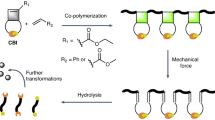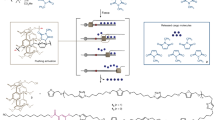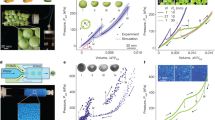Abstract
Despite the versatility of synthetic chemistry, certain combinations of mechanical softness, strength, and toughness can be difficult to achieve in a single material. These combinations are, however, commonplace in biological tissues, and are therefore needed for applications such as medical implants, tissue engineering, soft robotics, and wearable electronics1,2,3,4,5,6,7,8,9. Present materials synthesis strategies are predominantly Edisonian, involving the empirical mixing of assorted monomers, crosslinking schemes, and occluded swelling agents, but this approach yields limited property control2,10,11,12,13,14,15,16. Here we present a general strategy for mimicking the mechanical behaviour of biological materials by precisely encoding their stress–strain curves in solvent-free brush- and comb-like polymer networks (elastomers). The code consists of three independent architectural parameters—network strand length, side-chain length and grafting density. Using prototypical poly(dimethylsiloxane) elastomers, we illustrate how this parametric triplet enables the replication of the strain-stiffening characteristics of jellyfish, lung, and arterial tissues.
This is a preview of subscription content, access via your institution
Access options
Access Nature and 54 other Nature Portfolio journals
Get Nature+, our best-value online-access subscription
$29.99 / 30 days
cancel any time
Subscribe to this journal
Receive 51 print issues and online access
$199.00 per year
only $3.90 per issue
Buy this article
- Purchase on Springer Link
- Instant access to full article PDF
Prices may be subject to local taxes which are calculated during checkout



Similar content being viewed by others
References
Minev, I. R. et al. Biomaterials. Electronic dura mater for long-term multimodal neural interfaces. Science 347, 159–163 (2015)
Chen, Q. Z., Liang, S. L. & Thouas, G. A. Elastomeric biomaterials for tissue engineering. Prog. Polym. Sci. 38, 584–671 (2013)
Griffith, L. G. & Naughton, G. Tissue engineering—current challenges and expanding opportunities. Science 295, 1009–1014 (2002)
Vatankhah-Varnoosfaderani, M. et al. Bottlebrush elastomers: a new platform for freestanding electroactuation. Adv. Mater. 29, 1604209 (2017)
Rus, D. & Tolley, M. T. Design, fabrication and control of soft robots. Nature 521, 467–475 (2015)
Majidi, C. Soft robotics: a perspective—current trends and prospects for the future. Soft Robotics 1, 5–11 (2014)
Kim, D. H. et al. Epidermal electronics. Science 333, 838–843 (2011)
Rogers, J. A., Someya, T. & Huang, Y. Materials and mechanics for stretchable electronics. Science 327, 1603–1607 (2010)
Lv, S. et al. Designed biomaterials to mimic the mechanical properties of muscles. Nature 465, 69–73 (2010)
Meyers, M. A., Chen, P.-Y., Lin, A. Y.-M. & Seki, Y. Biological materials: structure and mechanical properties. Prog. Mater. Sci. 53, 1–206 (2008)
Green, J. J. & Elisseeff, J. H. Mimicking biological functionality with polymers for biomedical applications. Nature 540, 386–394 (2016)
Zhong, M., Wang, R., Kawamoto, K., Olsen, B. D. & Johnson, J. A. Quantifying the impact of molecular defects on polymer network elasticity. Science 353, 1264–1268 (2016)
Akbari, M. et al. Composite living fibers for creating tissue constructs using textile techniques. Adv. Funct. Mater. 24, 4060–4067 (2014)
Gong, J. P., Katsuyama, Y., Kurokawa, T. & Osada, Y. Double-network hydrogels with extremely high mechanical strength. Adv. Mater. 15, 1155–1158 (2003)
Grindy, S. C. et al. Control of hierarchical polymer mechanics with bioinspired metal-coordination dynamics. Nat. Mater. 14, 1210–1216 (2015)
Yu, B. et al. An elastic second skin. Nat. Mater. 15, 911–918 (2016)
Daniel, W. F. et al. Solvent-free, supersoft and superelastic bottlebrush melts and networks. Nat. Mater. 15, 183–189 (2016)
Patel, S. K., Malone, S., Cohen, C., Gillmor, J. R. & Colby, R. H. Elastic modulus and equilibrium swelling of poly(dimethylsiloxane) networks. Macromolecules 25, 5241–5251 (1992)
Fetters, L. J., Lohse, D. J., García-Franco, C. A., Brant, P. & Richter, D. Prediction of melt state poly(α-olefin) rheological properties: the unsuspected role of the average molecular weight per backbone bond. Macromolecules 35, 10096–10101 (2002)
Pakula, T. et al. Molecular brushes as super-soft elastomers. Polymer 47, 7198–7206 (2006)
Daniels, D., McLeish, T., Crosby, B., Young, R. & Fernyhough, C. Molecular rheology of comb polymer melts. 1. Linear viscoelastic response. Macromolecules 34, 7025–7033 (2001)
Kapnistos, M., Vlassopoulos, D., Roovers, J. & Leal, L. Linear rheology of architecturally complex macromolecules: comb polymers with linear backbones. Macromolecules 38, 7852–7862 (2005)
Daniel, W. F. et al. Bottlebrush-guided polymer crystallization resulting in supersoft and reversibly moldable physical networks. Macromolecules 50, 2103–2111 (2017)
Zhang, J., Schneiderman, D. K., Li, T., Hillmyer, M. A. & Bates, F. S. Design of graft block polymer thermoplastics. Macromolecules 49, 9108–9118 (2016)
Xia, Y., Olsen, B. D., Kornfield, J. A. & Grubbs, R. H. Efficient synthesis of narrowly dispersed brush copolymers and study of their assemblies: the importance of side chain arrangement. J. Am. Chem. Soc. 131, 18525–18532 (2009)
Bolton, J. & Rzayev, J. Synthesis and melt self-assembly of PS–PMMA–PLA triblock bottlebrush copolymers. Macromolecules 47, 2864–2874 (2014)
Carrillo, J.-M. Y., MacKintosh, F. C. & Dobrynin, A. V. Nonlinear elasticity: from single chain to networks and gels. Macromolecules 46, 3679–3692 (2013)
Gouinlock, E. V. & Porter, R. S. Linear dynamic mechanical properties of an SBS block copolymer. Polym. Eng. Sci. 17, 535–543 (1977)
Takano, A., Kamaya, I., Takahashi, Y. & Matsushita, Y. Effect of loop/bridge conformation ratio on elastic properties of the sphere-forming ABA triblock copolymers: preparation of samples and determination of loop/bridge ratio. Macromolecules 38, 9718–9723 (2005)
Luo, Y. et al. Poly(dimethylsiloxane-b-methyl methacrylate): a promising candidate for sub-10 nm patterning. Macromolecules 48, 3422–3430 (2015)
Acknowledgements
We thank the National Science Foundation for funding (grants DMR 1436201, DMR 1407645 and DMR 1624569). We thank M. Rubinstein for discussions; and E. T. Samulski, G. R. Newkome and K. A. Sheyko for reviewing the paper prior to submission.
Author information
Authors and Affiliations
Contributions
M.V.-V. designed, synthesized and characterized the monomers, polymer melts and elastomers (bottlebrushes, combs and ABA-based). W.F.M.D. performed atomic-force microscopy experiments, rheology measurements and analysis. M.H.E. synthesized PDMS combs and revised the manuscript. A.A.P. synthesized PDMS combs. K.M. provided guidance on the synthesis of bottlebrushes. H.L. and A.V.D. provided theoretical analysis of mechanical properties, developed the theoretical foundation for materials design and ABA networks, and performed computer simulations. S.S.S. was the principal investigator. S.S.S. and A.V.D. were primary writers of the manuscript. All authors discussed the results and provided feedback on the manuscript.
Corresponding authors
Ethics declarations
Competing interests
The authors declare no competing financial interests.
Additional information
Reviewer Information Nature thanks D. Gracias, J. Kornfield and D. Vlassopoulos for their contribution to the peer review of this work.
Publisher's note: Springer Nature remains neutral with regard to jurisdictional claims in published maps and institutional affiliations.
Supplementary information
Supplementary Information
This file contains Supplementary Information sections S1-S7, which include Supplementary Figures, Tables, Data and additional references. (PDF 3505 kb)
Rights and permissions
About this article
Cite this article
Vatankhah-Varnosfaderani, M., Daniel, W., Everhart, M. et al. Mimicking biological stress–strain behaviour with synthetic elastomers. Nature 549, 497–501 (2017). https://doi.org/10.1038/nature23673
Received:
Accepted:
Published:
Issue Date:
DOI: https://doi.org/10.1038/nature23673
This article is cited by
-
Forensics of polymer networks
Nature Materials (2023)
-
Conductive and elastic bottlebrush elastomers for ultrasoft electronics
Nature Communications (2023)
-
Thermal, mechanical, and morphological studies of a depolymerizable graft copolymer thermoplastic
Polymer Journal (2023)
-
Preparation of dual-cross network polymers by the knitting method and evaluation of their mechanical properties
NPG Asia Materials (2022)
-
Anomalous elasticity and damping in covalently cross-linked graphene aerogels
Communications Physics (2022)
Comments
By submitting a comment you agree to abide by our Terms and Community Guidelines. If you find something abusive or that does not comply with our terms or guidelines please flag it as inappropriate.



